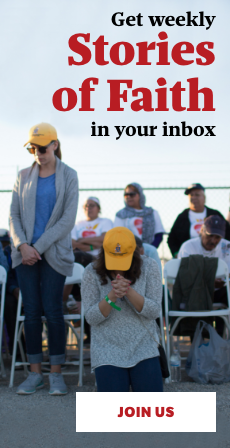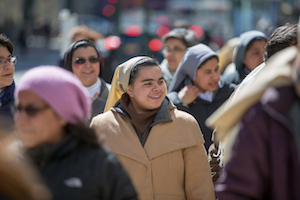
Approximately forty Catholic sisters descended on New York City this past week for a field trip to the Big Apple. They are part of Catholic Extension Society’s U.S. – Latin American Sisters Exchange Program, an initiative that provides funding for women religious of Latin America to live and study in the U.S. for five years, while they minister to underserved communities of immigrants in poor and rural U.S. dioceses.
The cohort of sisters, representing twelve unique religious congregations and six Latin American countries, convened in New York as part of their ongoing cultural and academic training in the U.S. Their intent was to visit some of the most significant historical sites of the city, to a gain a deeper appreciation of the history, beauty and struggles of this nation.
After a brief visit with New York’s Cardinal Dolan at St. Patrick’s Cathedral, the sisters fittingly began their educational tour with an excursion to the Statue of Liberty. These religious women, who serve today’s new waves of American immigrants, could easily identify with the monument’s famous inscription which beacons the ‘tired, poor and huddled masses’ of the world ‘yearning to breathe free.’
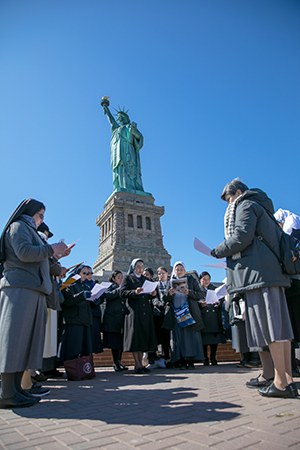
At the feet of Lady Liberty, the sisters offered a heartfelt prayer on behalf of the tens of thousands of immigrants they collectively serve throughout the nation. “Oh Jesus,” they prayed in one voice, “bless the immigrants. Keep them close to your heart.” The prayer called to mind that in God’s holy Church “no one is a stranger” and we are all pilgrims journeying “together toward our common celestial home.”
The sisters concluded the ritual by learning to chant “U-S-A! U-S-A! U-S-A!” to the delight of the other tourists passing by.
They continued to the Ellis Island Museum, the once-bustling port of entry for ships that brought 12 million immigrants in the late 19th and early 20th centuries. Several of the sisters were captivated by a particular exhibit, which showcased the history of anti-immigrant sentiment spearheaded by the “Know Nothing Party.” They closely studied an old political cartoon of the Pope, depicted with a drawn sword invading the shores of America to apparently destroy the country’s beliefs and way of life. The image captured the resentment that many Catholic immigrants from Europe faced when they arrived in America. The sisters are firsthand witnesses of this same fear of the stranger that directly impacts the communities of immigrants they work with today.
Learning about the painful history of anti-immigrant sentiment was an incredibly illuminating exercise for the sisters. Sr. Isabel Doñate Valdez, who serves migrant farmworkers in Central Washington state, reflected, “I have seen how people from many places across the world have come here to better their lives, but who were faced with great challenges when they came here.”
Despite periodic flare-ups of nativist fear, the sisters commented how this nation’s ideals of inclusion and unity amid our diversity have prevailed throughout our history.
Sr. Maria de la Luz Solis Lara who works with indigenous Mexican immigrants in California’s Salinas Valley, marveled at the great richness of American culture as a consequence of its long history of immigration. She said, “We are all brothers and sisters no matter our race or color, and what is most important is that we live in unity with one another.” She said her trip to New York allowed her to appreciate that no matter what walk of life we come from, “all people can know God and experience his love.”
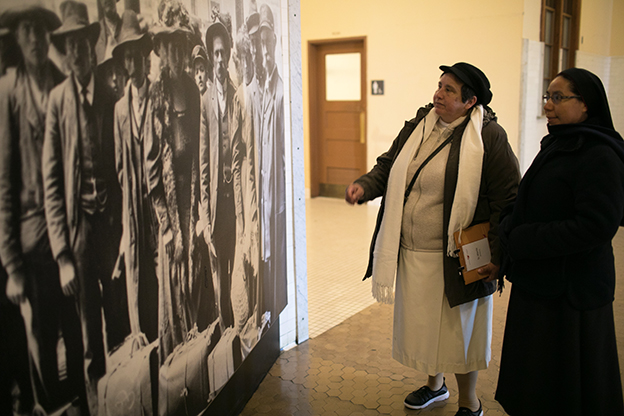
The sisters also had the opportunity to visit the 9/11 memorial. With humble reverence, they gathered together and offered a soft-spoken prayer for all the innocent people and heroes who lost their lives, and for all the families that mourn them. Sr. Yelitza Ayala, who serves families in rural East Texas, led the prayer, asking God to allow “Peace to reign in our hearts and in our souls and in the whole world.”
Afterwards, she reflected on the experience of visiting this sacred ground, “To come here is a blessing,” she said. “To pray for these people, to pray for this country which welcomes people from every part of the world. This place is a memorial of how people can be together—serving, loving, sharing in peace, no matter what color of your face, no matter what your eyes look like, you are part of the one human race, you were created by God to love and serve… To see people walking in silence and praying it gives hope to all, especially for us, the sisters, who love and pray for people, for souls…We give you thanks for bringing us here.”
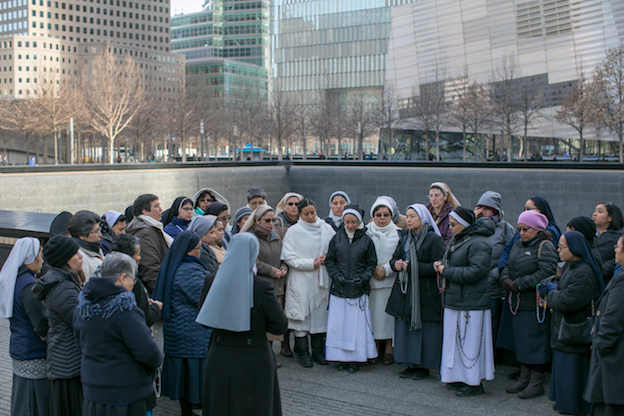
The sisters realize that to be successful missionaries they have but one fundamental task: to fall in love with the people and the country they have been called to serve. Now in their fourth year of this exchange program, these Latin American sisters have magnificently accomplished that core task.
To symbolically express their love of their host country, the nuns marched into the heart of Time’s Square where they unfurled an American flag and snapped a picture to send to their mother houses throughout Latin America. The image of these photogenic sisters clinging to the stars and stripes, captures their deep and growing love of the American people, both immigrants and native born, and their commitment to building up this nation by forming communities, strengthening families, and educating youth.
Sr. Doñate Valdez best summarized the sentiments of her peers on the bus ride home, “After visiting so many beautiful places today, I can see that the beauty we beheld is simply a reflection of the beauty that exists in the heart of humankind, which makes us capable of building such great structures and places.”
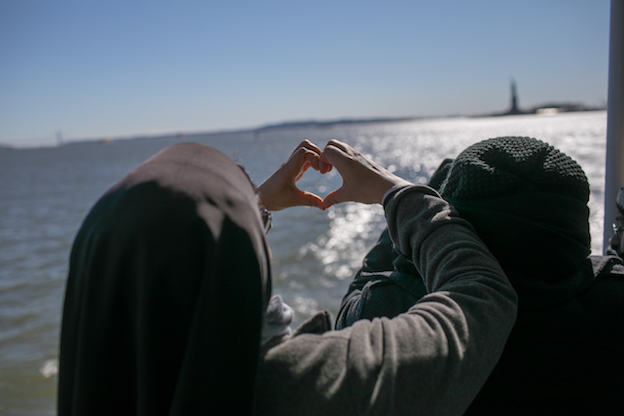
Catholic Extension Society is delighted that these sisters have come to recognize that America is, indeed, beautiful. But, Catholic Extension Society also recognizes the sisters’ immense contribution to make America even more beautiful through their work on the missionary frontiers of this country, as they welcome and integrate today’s immigrants into the Church and our society. In so doing, these inspiring women are taking part in our history as a country.
